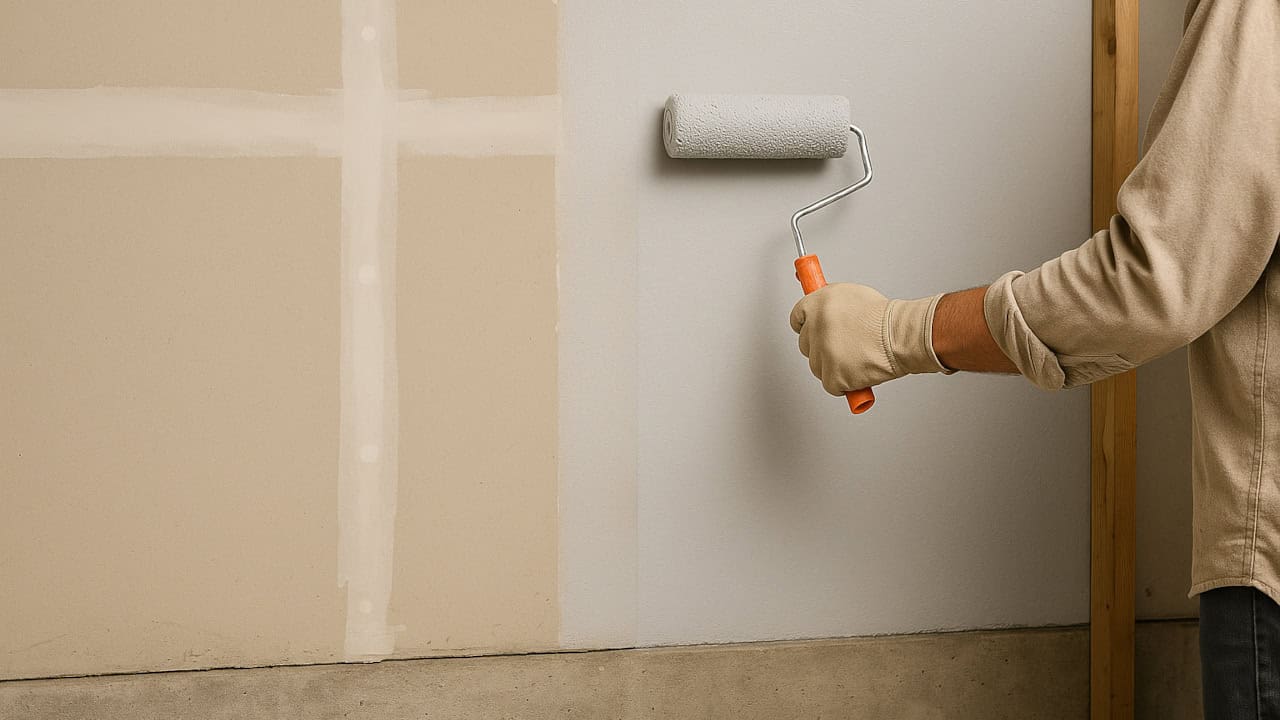How To Waterproof Drywall in Garage (Complete Guide)
Prevent costly moisture damage with proven waterproofing methods. From $2 paint solutions to professional membranes - protect your investment.
Garage moisture damage costs homeowners $3,000-8,000 in repairs, yet most waterproofing solutions cost under $200 to implement. Garages face unique challenges from temperature swings, vehicle moisture, and water infiltration.
Unlike interior rooms, garages lack proper vapor barriers and climate control, making drywall vulnerable to mold, mildew, and structural damage. The right waterproofing method depends on your budget, moisture levels, and long-term plans.
This guide covers five proven methods from basic paint treatments to professional membrane systems, plus alternatives like moisture-resistant boards and non-drywall options.
How to Waterproof Drywall in Garage
Quick Answer: Use waterproof paint ($2-4/sq ft), moisture-resistant drywall ($1.50-3/sq ft), membranes ($5-12/sq ft), or FRP panels ($3-8/sq ft) based on your moisture exposure and budget.
Each method offers different levels of protection and cost investment. Paint treatments work for light moisture exposure, while membrane systems handle severe conditions like car wash bays or flood-prone areas.

1. Use Waterproof Paint and Primer
Waterproof paint and primer offers the simplest, most cost-effective drywall protection. One-coat solutions combine primer and paint, reducing labor time and providing 3-7 years of moisture protection.
Cost Breakdown: Materials cost $25-60 per average garage, labor 4-6 hours. Professional application runs $200-400 total.
Here's how to use these materials to protect your garage:
Application Steps
- Clean drywall thoroughly with dry then damp cloth
- Verify surface moisture requirements on product label
- Apply thin, even coat using roller for large areas, brush for corners
- Allow full cure time (typically 24-48 hours) before second coat if needed
Quality waterproof coatings last two to five years before requiring touch-ups. Test effectiveness annually by applying water drops to small areas - proper coatings should bead rather than absorb.
2. Use Water-Resistant Drywall
Water-resistant drywall prevents moisture problems during initial construction or major renovations. Four main types offer different protection levels and costs:
Drywall Types Compared: Standard ($0.50/sq ft), Greenboard ($0.65/sq ft), Purpleboard ($0.85/sq ft), Paperless ($1.20/sq ft). Choose based on moisture exposure levels.
Greenboard (Water-Resistant)
Features green paper facing with moisture-resistant core. Suitable for moderate moisture areas but not fully waterproof.
Purpleboard (Mold-Resistant)
Premium option with inherent mold and mildew resistance. Costs about 30% more than standard drywall but offers superior protection.
Blue Board and Paperless Options
Blue Board: Extremely water-resistant, ideal for high-moisture garages. Similar cost to greenboard with better performance.
Paperless Drywall: Fiberglass-faced panels resist mold and moisture. Premium option at 2x greenboard cost but maximum durability.
Installation Reality: Moisture-resistant drywall requires the same installation techniques as standard drywall, making it an easy upgrade.
3. Apply a Waterproof Membrane
Waterproof membranes provide professional-grade protection for severe moisture conditions. Available as sheet membranes or liquid-applied systems, they create continuous barriers over existing drywall.
To apply a waterproof membrane, first, get your drywall ready. Then:
Sheet Membrane Installation
- Clean surface and dampen to control adhesive curing speed
- Apply adhesive with notched trowel in consistent direction
- Press membrane firmly, working out air bubbles from center outward
- Seal all seams, corners, and transitions with compatible sealing strips
Liquid Membrane Systems
Polyurethane liquid membranes apply like thick paint but cure to flexible, seamless barriers. Typically require two coats with sand broadcast for texture and additional protection.
4. Apply Fiberglass-Reinforced Plastic (FRP)
Fiberglass-reinforced plastic panels create durable, easy-to-clean surfaces over existing drywall. Popular in commercial applications, FRP panels resist moisture, chemicals, and impact damage.
FRP Advantage: Nearly indestructible once installed. Perfect for garages with car maintenance, sports equipment storage, or workshop activities.
To apply, here's what you need to do:
FRP Installation Process
- Prepare clean, level drywall surface
- Cut panels to size allowing for expansion gaps
- Apply adhesive in cross-hatch pattern, press panels firmly
- Roll out air bubbles with laminate roller
- Seal joints with silicone caulk after trim installation
Maintenance Benefit: FRP panels clean with simple soap and water, resisting stains, mold, and chemical damage indefinitely.
5. Use Non-Drywall Materials
Non-drywall alternatives eliminate moisture concerns entirely while often providing additional functionality. Consider these options for new construction or major renovations:
Pegboard
Pegboard: Plastic versions provide waterproof storage solutions. Installation over studs creates organized, moisture-resistant walls.
Wall Panels
Wall Panels: Decorative options include PVC, composite, and metal panels designed for moisture resistance. Higher initial cost but faster installation and superior durability.
Conclusion
Garage drywall waterproofing prevents costly moisture damage while extending wall life by decades. Choose your method based on budget, moisture exposure, and long-term needs.
Paint treatments work for most garages and cost under $100 for materials. Severe moisture conditions or new construction justify membrane or FRP panel investments.
Start with proper surface preparation regardless of method. Clean, dry surfaces ensure maximum adhesion and longevity. Address existing damage by repairing small holes in drywall before waterproofing. When in doubt, address existing moisture sources before applying waterproofing systems.
🔧 Method Selection Guide
Light Moisture: Waterproof paint ($25-60). Moderate Moisture: Greenboard + paint ($100-200). Severe Conditions: Membrane/FRP systems ($300-800). New Construction: Moisture-resistant drywall from start. Choose the protection level that matches your garage's moisture challenges.
